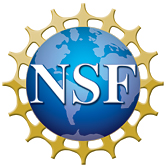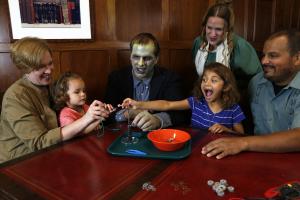Celebrating the 200th anniversary of the publication of Mary Shelley's novel.
Project overview
Frankenstein is a modern myth: a 200-year-old story that explores themes of human creativity, societal responsibility, and scientific ethics. These themes continue to resonate today. As citizens with access to incredible tools for creation and transformation, we need to understand the fundamentals of science and technology and develop the skills to actively participate in civic and policy discussions.
Frankenstein200 takes on the challenge of supporting learning related to responsible innovation. The project uses themes from Frankenstein to examine emerging technologies like artificial intelligence and genetic engineering, while promoting the development of 21st century skills related to creative collaboration and critical thinking. Frankenstein200 explores three important questions: What is life?, Why do we create?, and What are our responsibilities as creators, scientists, and engineers?
Frankenstein200 is a transmedia project, studying the learning that occurs when people participate in a combination of hands-on activities and immersive digital experiences. The Frankenstein200 kit includes seven hands-on activities that encourage creativity and reflection about responsible innovation.
Background - Mary Shelley’s Frankenstein
Victor Frankenstein and the “monster” he created first appeared 200 years ago in Mary Shelley’s novel Frankenstein. Since Shelley published her novel, the Frankenstein characters have appeared in plays, movies, TV shows, comic books, and many other places. You may recognize Frankenstein’s creature as a Halloween costume, a classic Hollywood monster, or the complex character in Shelley’s story.
Mary Wollstonecraft Shelley (1797–1851) was an English writer. She is best known for her novel Frankenstein: Or, The Modern Prometheus, published in 1818.
Frankenstein200 kit
https://www.nisenet.org/frankensteinkit
Audience:
Kit activities are designed for family audiences including children, and work particularly well for ages 6 and up. These activities are suitable for use in museums and other informal learning settings such as libraries and afterschool programs. They do not require special lab facilities or equipment.
Kit contents include:
- A set of hands-on activities that use the Frankenstein story to inspire deeper conversations about scientific and technological creativity and social responsibility. The activities have been tested with public audiences and reviewed by experts.
- Professional development and training materials including guides and videos.
- Promotional and marketing materials.
Digital Kit Download
The digital kit is available as a free download:
Online Alternate Reality Game
The project has also developed an online alternate reality game that immerses players in the modern-day Laboratory for Innovation and Fantastic Explorations (or L.I.F.E.). This interactive fictional story imagines what might happen if a character named Dr. Tori Frankenstein picked up where her ancestor Victor left off.
Please note the Frankenstein200 L.I.F.E. online Alternate Reality Game is no longer live.
Physical Kits
A select number of physical Frankenstein200 kits have been sent out to museums and libraries across the country that will be holding events to celebrate the bicentennial of the publication of Mary Shelley’s Frankenstein. Free digital downloads are available to everyone.
Recipients of physical kits are required to:
- Celebrate the 200th anniversary of Frankenstein: Host at least one dedicated event featuring Frankenstein200 kit activities with public audiences in January 2018. This month marks the 200th anniversary of publication of Mary Shelley’s novel Frankenstein.
- Utilize in seasonal programming: Use Frankenstein200 kit activities and related materials in on-site or offsite public programming in October 2018. This can be as simple as incorporating kit activities into Halloween or other seasonal programming your organization already offers for the month of October. It does not require another public event dedicated to this activity kit.
- Reach underserved audiences: Partner with a local library or community organization (e.g. Boys and Girls Clubs, YMCA, Big Brothers/Big Sisters, afterschool programs) to reach audiences that are traditionally underserved by cultural and informal learning institutions. This requirement can be met as part of the seasonal programming described above.
- Report on your activities: Submit an online report by March 1, 2018 detailing the January event and participate in a phone interview with a member of the ASU team in November 2018 to discuss the Halloween programming.
Timeline
- April 20, 2017: Application opens online for free Frankenstein200 kits
- June 1, 2017: Deadline to submit application for physical kit
- July 1, 2017: Notification of award decisions
- October, 2017: Physical kits delivered to successful applicants
- October 19, 2017: Professional development workshops for recipients of physical kits
- November, 2017: Digital kits available for download
- January 2018: Host required public event in conjunction with 200th anniversary of the publication of Frankenstein
- March 1, 2018: Reports due online (template will be made available for review in early 2018)
- October 2018: Integrate kit activities into established on-site or off-site seasonal programming
Learn More
Additional information is available at:
Project partners
The project is led by:
Project team members include:
With educational and scientific advisement from:
- Children’s Museum of Pittsburgh
- Illinois Institute of Technology
- J. Craig Venter Institute
- Keats-Shelley Association of America
- Museum of Science, Boston
- New York Public Library
 Funding
Funding
This project is supported by a grant from the National Science Foundation
to Arizona State University (DRL-1516684)
Acknowledgements
This material is based upon work supported by the National Science Foundation under Grant Number DRL-1516684. Any opinions, findings, and conclusions expressed in this material are those of the authors and do not necessarily reflect the views of the National Science Foundation.




